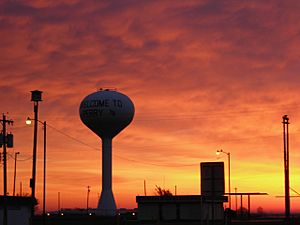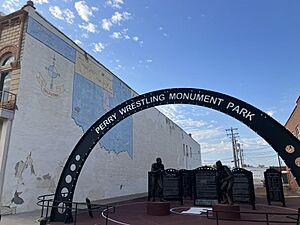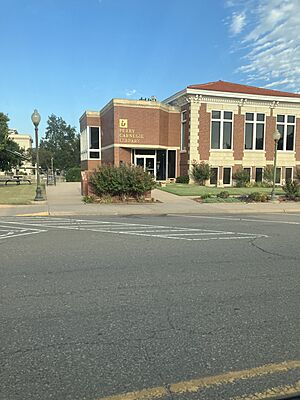Perry, Oklahoma facts for kids
Quick facts for kids
Perry, Oklahoma
|
|
|---|---|
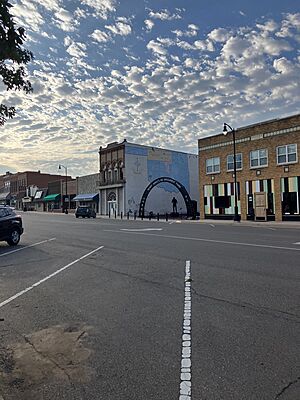
Downtown Perry (2024)
|
|
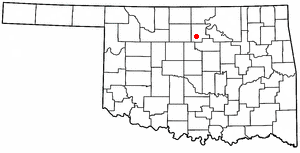
Location within Noble County and Oklahoma
|
|
| Country | United States |
| State | Oklahoma |
| County | Noble |
| Area | |
| • Total | 55.0009 sq mi (20.14 km2) |
| • Land | 6.82 sq mi (17.66 km2) |
| • Water | 0.96 sq mi (2.48 km2) |
| Elevation | 1,060 ft (320 m) |
| Population
(2020)
|
|
| • Total | 4,484 |
| • Density | 657.77/sq mi (253.95/km2) |
| Time zone | UTC−6 (CST) |
| • Summer (DST) | UTC−5 (CDT) |
| ZIP code |
73077
|
| Area code | 580 |
| FIPS code | 40-58250 |
| GNIS feature ID | 2411404 |
Perry is a city in Noble County, Oklahoma, United States. It's also the main town, or county seat, of Noble County. In 2020, about 4,484 people lived here. Perry is well-known as the home of Ditch Witch, a company that makes construction equipment.
Contents
History of Perry
How Perry Began
In 1836, the Treaty of New Echota gave the Cherokee Outlet land to the Cherokee people. This land was for them to travel and hunt in the West. It was also extra land for them to settle after moving from their original homes in Georgia.
Perry was first called Wharton. This was the name of a train station built in 1886. It was part of the Santa Fe Railway system. The station was about a mile south of where Perry is today.
Before the "Cherokee Outlet Opening" in 1893, the U.S. government picked a spot for a land office. This spot was a mile north of Wharton. A town grew around this office and was named after J.A. Perry. He was a government official who helped plan these new towns. Noble County, where Perry is located, was named after John Willock Noble. He was a government secretary at the time.
Some famous outlaws were in the area before the land opening. The Dalton Gang robbed a train in Wharton in 1891. Another outlaw, Bill Doolin, was also in the area. To keep order, U.S. Marshal E.D. Nix and 100 deputies were sent to police the area.
The Land Run of 1893
On September 16, 1893, at noon, a huge event called "the run" for land began. About 90,000 people, including men, women, and children, took part. By the end of that day, 40,000 people had set up tents in Perry.
One person, Jack Tearney, reached Perry in just 31 minutes. By 4:00 p.m., he had opened a saloon called "Blue Bell." He sold beer for $1.00 a bottle because water was hard to find. He sold 38,000 glasses that first day!
The original town area was nicknamed "Hell's Half Acre." It had about 110 saloons and gambling houses. Perry officially became a city on September 20, 1893.
Perry in the 1900s
In 1902, Carl Malzahn started a blacksmith shop in Perry. His sons, Charles and Gus, took over in 1913. They called it Malzahn Brothers' General Blacksmithing. They focused on fixing equipment for nearby oil fields.
After Gus passed away, Charles renamed the business Charlie’s Machine Shop. Charles's son, Ed, joined the business in 1944. Ed was an engineer. He saw that people needed a machine to dig trenches for utility lines instead of digging by hand.
By 1948, Ed created a successful small machine called the Ditch Witch. Soon, Ditch Witch became a very successful company. It is now owned by The Toro Company. Ditch Witch is the biggest employer in Perry and Noble County, with about 1,300 workers.
In 1995, a man named Timothy McVeigh was stopped near Perry by a police officer. He was arrested for carrying a firearm. A few days later, he was identified as a suspect in the Oklahoma City bombing.
Perry Today
Perry has changed its government style to a Home Rule Charter. This means the city council makes laws and sets policies. A city manager then handles the daily operations of the city. They work together to use the city's resources wisely.
Perry is the smallest town in Oklahoma that has its own daily newspaper.
Geography of Perry
Perry is about 60 miles (97 km) north of Oklahoma City. It is also about 100 miles (161 km) south of Wichita, Kansas.
The city covers about 6.8 square miles (17.6 square kilometers) in total. Most of this area, about 6.1 square miles (15.8 square kilometers), is land. The rest, about 0.8 square miles (2.1 square kilometers), is water.
Population Information
| Historical population | |||
|---|---|---|---|
| Census | Pop. | %± | |
| 1900 | 3,351 | — | |
| 1910 | 3,133 | −6.5% | |
| 1920 | 3,154 | 0.7% | |
| 1930 | 4,206 | 33.4% | |
| 1940 | 5,045 | 19.9% | |
| 1950 | 5,137 | 1.8% | |
| 1960 | 5,210 | 1.4% | |
| 1970 | 5,341 | 2.5% | |
| 1980 | 5,796 | 8.5% | |
| 1990 | 4,978 | −14.1% | |
| 2000 | 5,230 | 5.1% | |
| 2010 | 5,126 | −2.0% | |
| 2020 | 4,484 | −12.5% | |
| U.S. Decennial Census | |||
In 2000, there were 5,230 people living in Perry. There were 2,203 households, and 1,445 families. The population density was about 860 people per square mile (332 people per square kilometer).
Most people in Perry were White (89.7%). There were also African American (3.1%), Native American (3.3%), and Asian (0.5%) residents. About 1.8% of the population was Hispanic or Latino.
About 29.4% of households had children under 18. The average household had 2.31 people, and the average family had 2.88 people.
The median age in Perry was 38 years old. This means half the people were younger than 38, and half were older. About 24% of the population was under 18.
The median income for a household in Perry was $30,653. For families, it was $37,731. About 14% of the population lived below the poverty line.
Economy
The main business in Perry is Charles Machine Works, which makes Ditch Witch machinery. This company is the biggest employer in the city, with over 1,300 workers. In 2022, the company announced plans to expand. They are adding more space and creating 100 new jobs.
Education and Learning
Perry has several schools for different age groups:
- Perry High School (grades 9-12)
- Perry Junior-High School (grades 7-8)
- Perry Upper Elementary School (grades 3-6)
- Perry Lower Elementary School (grades Pre-K-2)
Perry High School is famous for its wrestling program. It's one of the most successful in the United States. Since 1952, the school has won 63 state championships. Many individual wrestlers have also won state titles.
Perry is also home to a Carnegie Library. These libraries were built with money from Andrew Carnegie, a famous businessman.
Historic Places to Visit
Several places in Perry are listed on the National Register of Historic Places. This means they are important historical sites:
Parks and Recreation
The Cherokee Strip Museum is a great place to learn about the history of the Cherokee Outlet. It shows what life was like for the people who settled this area. The museum includes an old schoolhouse, The Rose Hill School. Fourth-grade students can visit to see what school was like long ago. There's also a Blacksmith Shop where visitors can see how tools were made in pioneer times.
Since 2016, Perry has the Perry BMAC Baseball Complex. It has four baseball fields with digital scoreboards. There are also covered bleachers and a snack area.
Perry Lake is a popular spot for outdoor fun. It's about two miles off US-77. The lake was first used for the city's water supply. Now, it's mainly for recreation. You can go boating, skiing, swimming, fishing, and camping there.
CCC Lake and Park was built in 1934 by the Civilian Conservation Corps (CCC). This was part of the New Deal program. The lake is now Perry's main water source. You can swim and fish there, but only small electric motors are allowed on boats. The park has three pavilions you can use. There's also Centennial Church, a beautiful old building from 1894. It was moved to the park and fixed up by 2007. You can reserve these spots for special events.
Other nearby lakes include Lake McMurtry and Lake Carl Blackwell.
Notable People from Perry
Many interesting people have connections to Perry:
- Thomas H. Doyle: A lawyer, politician, and judge who lived in Perry.
- Ralph Foster: An American football player.
- Robert Galbreath, Jr.: Started a newspaper in Perry and later discovered a large oil reserve.
- Jake Hager: A professional wrestler and MMA fighter.
- Danny Hodge: A professional wrestler, Olympic wrestler, and boxer.
- Henry S. Johnston: A former governor of Oklahoma.
- Little Britches: A female bandit who lived in Perry for a short time.
- Sharron Miller: An award-winning television director, producer, and writer.
- Billy Pricer: An American football player.
- Jack van Bebber: An Olympic gold medalist in freestyle wrestling.
- La Vern E. Weber: A high-ranking United States Army general.
See also
 In Spanish: Perry (Oklahoma) para niños
In Spanish: Perry (Oklahoma) para niños


